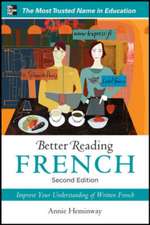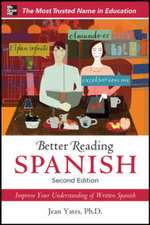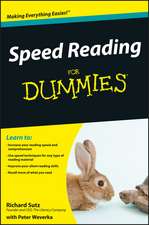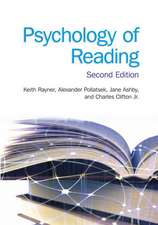Content Area Reading and Learning: Instructional Strategies, 3rd Edition
Editat de Diane Lapp, James Flood, Nancy Farnanen Limba Engleză Paperback – 7 sep 2007
This book is organized around five themes:
- Content Area Reading: An Overview
- The Teacher and the Text
- The Students
- The Instructional Program
- School Culture and Environment in Middle and High School Classrooms.
This textbook is intended as a primary text for courses on middle and high school content area literacy and learning.
Preț: 670.12 lei
Preț vechi: 788.37 lei
-15% Nou
Puncte Express: 1005
Preț estimativ în valută:
128.23€ • 137.12$ • 106.91£
128.23€ • 137.12$ • 106.91£
Carte tipărită la comandă
Livrare economică 17 aprilie-01 mai
Preluare comenzi: 021 569.72.76
Specificații
ISBN-13: 9780805852059
ISBN-10: 0805852050
Pagini: 672
Dimensiuni: 178 x 254 x 35 mm
Greutate: 1.24 kg
Ediția:3Revizuită
Editura: Taylor & Francis
Colecția Routledge
Locul publicării:Oxford, United Kingdom
ISBN-10: 0805852050
Pagini: 672
Dimensiuni: 178 x 254 x 35 mm
Greutate: 1.24 kg
Ediția:3Revizuită
Editura: Taylor & Francis
Colecția Routledge
Locul publicării:Oxford, United Kingdom
Public țintă
ProfessionalCuprins
Contents: Part I: Content Area Reading: An Overview. T.W. Bean, H. Harper, Content Area Reading: The Current State of the Art. Part II: The Teacher and the Text. C.M. Fairbanks, N.L. Roser, D.L. Schallert, The Role of Textbooks and Tradebooks in Content Area Reading. B.B. Armbruster, Matching Readers and Texts: The Continuing Quest. Part III: The Students. K. McArthur, T. Penland, F. Spencer, P. Anders, Why Content Area Literacy?: Focus on Students. T. Gunning, Engaging Students Who Are Struggling Toward Success as Content Area Readers. B.A. Shearer, M.R. Ruddell, Engaging Students' Interest and Participation in Learning. L.M. Sutherland, S. Botzakis, E.B. Moje, D.E. Alvermann, Bringing Youth Culture Into Content Learning and Literacy. G.E. García, M.V. Montavon, Making Content-Area Instruction Comprehensible for English Language Learners. Part IV: The Instructional Program. G. Ivey, The Content Area Teacher's Instructional Role: Moving Students Toward Strategic Independent Reading. L. Mikulecky, Literacy Demands for Employment: How Jobs Have Changed and What Teachers Can Do. B. Moss, Facts That Matter: Teaching Students to Read Informational Text. C. Santa, L. Havens, S. Harrison, Teaching Secondary Science Through Reading, Writing, Studying, and Problem Solving. F.R. Curcio, A.F. Artzt, Reading, Writing, and Mathematics: A Problem-Solving Connection. E.M. Schell, Empowering Readings in Social Studies. C. Jago, Understanding Literature: Reading in the English/Language Arts Classroom. C. Cox, The Arts and Literacy Across the Curriculum. W.G. Brozo, Authentic Contexts for Developing Language Tools in Vocational Education. L. Gentile, V. McMillan, Reading and Writing in Sports and Physical and Health Education. D.L. Grisham, T.D. Wolsey, Literacy and Technology Integration in the English/Language Arts Classroom. N. Farnan, L. Fearn, Writing to Learn in the Content Areas. M.F. Graves, W.H. Slater, Vocabulary Instruction in the Content Areas. D.M. Ogle, Study Techniques That Ensure Content Area Reading Success. R. Hoffman, Using Concept Mapping as an Effective Strategy in Content Area Instruction. J.F. Almasi, Using Questioning Strategies to Promote Students' Active Discussion and Comprehension of Content Area Material. L. Kucan, Multigenre Reading/Writing in the Content Areas. J. O'Flahavan, R. Tierney, Moving Beyond Reading and Writing in the Content Areas of Discipline-Based Inquiry. R. Pritchard, S. O'Hara, Assessment in the Content Areas: Solving the Assessment Puzzle. Part V: School Culture and Environment. N. Frey, D. Fisher, Strategies for Engagement and Motivation in Middle and High School Classrooms. M. Mraz, R.T. Vacca, J.L. Vacca, Creating Response-Centered Learning Environments: Using Authentic Texts to Extend and Enrich the Curriculum. J. Barton, K.D. Wood, Lesson Planning for Best Practices in the Content Areas.
Notă biografică
James Flood, Diane Lapp, Nancy Farnan
Descriere
This text addresses instructional issues and provides a wealth of classroom strategies that will enable all middle and secondary teachers to effectively teach their students in ways that develop both content concepts and strategies for continued learning







